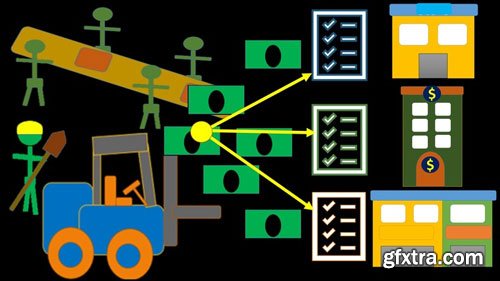
Genre: eLearning | Language: English + .VTT | Duration: 11.5 hours | Size: 4.63 GB
What Will I Learn?
Describe cost classifications and their importance.
Explain the differences in financial statements for a manufacturing company versus a merchandising company.
List the cost flow process for a manufacturing company.
Compare a job cost system and process cost system and explain when each would be used.
Describe the cost flows in a job cost system.
List and describe documents used in a job cost system.
Explain the concept of overhead and how it is used.
Calculate the predetermined overhead rate.
Allocate overhead to job using estimates.
Enter journal entries to record finished jobs and for the sale of jobs.
List and define key terms related to a job cost system.
Requirements
We should have a basic understanding of financial accounting and debits and credits
Description
Job cost system – Managerial Accounting
We will start by introducing managerial accounting or cost accounting topics that apply to companies that manufacture using either a job cost system or a process cost system.
The course will describe classifications for costs and the importance of being able to classify costs in different ways.
We will list and describe an outline of the process costs go through as they flow through the accounting process in a manufacturing company.
The course will compare the two major systems used to track inventory costs in a manufacturing company, the job cost system, and the process costs system. We will discuss when a company would use either a job cost system or a process cost system.
We will discuss the flow of inventory costs in a job cost system and track the process of costs related to raw materials, that then flow to work in process and factory overhead, to finished goods, and finally, are expensed in the form of cost of goods sold.
The course will list and describe key documents in the job cost system, documents that facilitate and help record the flow of costs in the system.
We will explain the concept of overhead and why it is needed, including the concept of actual overhead incurred and estimated overhead we apply to jobs. The course will show how to calculate the predetermined overhead rate and how to use this rate to estimate overhead allocated to jobs.
The course will record the journal entries related to costs as they flow through the job cost system including journal entries for the transfer of raw materials to work in process and factory overhead, the incurrence of direct and indirect wages, and other overhead costs. We will enter journal entries to allocate overhead to work in process and to close out finished jobs from work in process to finished goods. We will also enter journal entries to record the sale and related costs of finished jobs.
We will also discuss key terms and definitions related to a job cost system and how they are used in practice.
In addition to the instructional videos, this course will include downloadable
• Downloadable PDF Files
• Excel Practice Files
• Multiple Choice Practice Questions
• Short Calculation Practice Questions
• Discussion Questions
The PDF files allow us to download reference information we can use offline and as a guide to help us work through the material.
Excel practice files will be preformatted so that we can focus on the adjusting process and learning some of the basics of Excel, like addition, subtraction, and cell relationships.
Multiple choice example question helps us improve our test-taking skills by reducing the information into the size and format of multiple choice questions and discussing how to approach these questions.
Short calculation questions help us reduce problems that have some calculation down to a short format that could be used in multiple choice questions.
Discussion Question will provide an opportunity to discuss these topics with the instructor and other students, a process many students find very helpful because it allows us to see the topic from different viewpoints.
Who will we be learning from?
You will be learning from somebody who has technical experience in accounting concepts and in accounting software like QuickBooks, as well as experience teaching and putting together curriculum.
You will be learning from somebody who is a:
• CPA – Certified Public Accountant
• CGMA – Chartered Global Management Accountant
• Master of Science in Taxation
• CPS – Certifies Post-Secondary Instructor
• Curriculum Development Export
As a practicing CPA the instructor has worked with many technical accounting issues and helped work through them and discuss them with clients of all levels.
As a CPA and professor, the instructor has taught many accounting classes and worked with many students in the fields of accounting, business, and business applications.
The instructor also has a lot of experience designing courses and learning how students learn best and how to help students achieve their objectives. Experience designing technical courses has also benefit in being able to design a course in a logical fashion and deal with problems related to technical topics and the use of software like QuickBooks Pro.
Who is the target audience?
Accounting students
Business owner
Anyone who whats to learn accounting
Top Rated News
- Sean Archer
- AwTeaches
- Learn Squared
- PhotoWhoa
- Houdini-Course
- Photigy
- August Dering Photography
- StudioGuti
- Creatoom
- Creature Art Teacher
- Creator Foundry
- Patreon Collections
- Udemy - Turkce
- BigFilms
- Jerry Ghionis
- ACIDBITE
- BigMediumSmall
- Boom Library
- Globe Plants
- Unleashed Education
- The School of Photography
- Visual Education
- LeartesStudios - Cosmos
- All Veer Fancy Collection!
- All OJO Images
- All ZZVe Vectors




